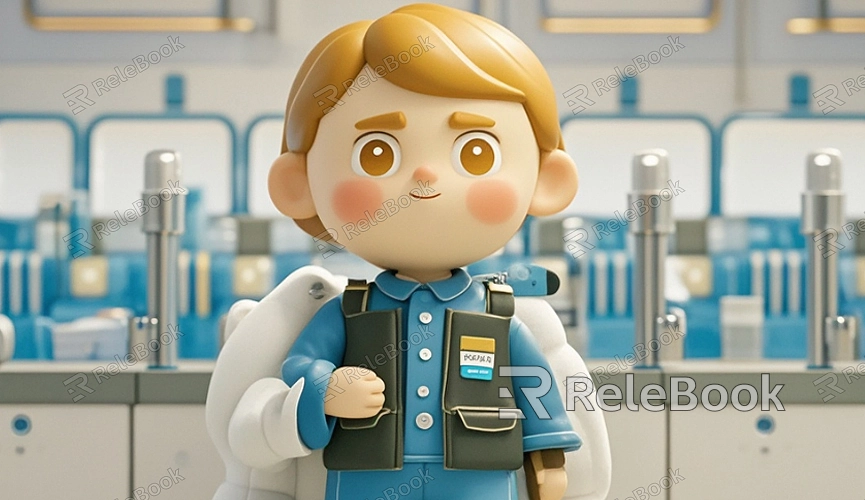How to Create 3D Cartoon Models?
In the field of design, 3D cartoon models have captivated many creators with their unique style and expressiveness. The process of creating these cartoon models is not only fun but also presents creative challenges. This article will delve into the various steps in making 3D cartoon models, helping you master this skill.

Define the Character Concept
Before starting the modeling process, it’s crucial to clarify the concept of the character or object you want to create. This phase can be achieved through sketches, mind maps, or reference images. Defining the character's personality, appearance, and overall style is essential. For instance, consider whether the character is cute, funny, or possesses unique features. These elements will form the foundation of your modeling, helping maintain consistency in the subsequent steps.
Choose the Right Software
Creating 3D cartoon models requires selecting suitable modeling software. Many excellent tools are available on the market, such as Blender, Maya, and ZBrush. Each software has its own unique features and applicable scenarios. For beginners, Blender is an excellent choice due to its open-source nature and wealth of learning resources. Once you’ve chosen your software, you can start the modeling process.
Create Basic Shapes
The first step in creating a model within the software is building basic shapes. Use geometric forms to construct a rough framework for the character, such as spheres, cubes, and cylinders. These basic shapes will help you form the overall silhouette of the character. At this stage, focus on sketching the proportions and pose of the character without worrying too much about details. Ensure that the relationships between the shapes are reasonable for easier detail work later.

Refine the Model
Once you have the basic shapes in place, the next step is to refine the model. Use sculpting tools or subdivision features to gradually add characteristics to the character. For example, you can stretch and scale parts to form features like eyes, mouths, and limbs. Be mindful to maintain the exaggerated characteristics typical of cartoon styles during refinement, which will make the character more lively and interesting. Additionally, refer to real objects to adjust details and enhance credibility.
Texturing and Materials
After refining the model, the next step is to add textures and materials. This process can breathe life into the model and increase its realism and visual appeal. Use UV mapping tools to unfold the model's surface for easier texturing. You can choose to hand-paint textures or use existing texture libraries, ensuring the colors are vibrant and fit the cartoon style. Proper use of lighting and shadow effects can add depth to the character.
Rigging
Adding a skeleton to the model is a crucial step for achieving animation effects. Rigging allows the character to move more naturally and smoothly during animation. In this phase, you can use rigging tools to create a skeletal structure and link it to the model. Make sure the rigging aligns with the character's movement logic for accurate positioning and motion in later animations.
Animation Production
Once rigging is complete, you can proceed to animation production. Design a series of actions based on the character’s traits, such as walking, jumping, or expressing emotions. You can use keyframe animation techniques to set the character's movements frame by frame or utilize pre-existing actions from an animation library. Ensure that the animations are fluid and expressive, conveying the character's personality and emotions effectively.
Rendering and Post-Processing
After completing the animations, the final step is rendering and post-processing. Choose the appropriate rendering settings, adjusting lighting, shadows, and backgrounds to achieve the best results. During rendering, experiment with different angles and camera perspectives to showcase the character's charm. Post-processing can be done using editing software, adding music and effects to enhance the overall visual impact and emotional resonance.
Feedback and Revisions
After finishing the model and animation, seeking feedback is an important step. You can invite friends or professionals to review your work and provide their suggestions and opinions. This can help you identify areas for improvement and inspire new creative ideas. Make revisions based on the feedback to enhance the appeal and expressiveness of the final work.
Publish and Share
Finally, the completed 3D cartoon model can be published on various platforms, allowing you to share your creation with a wider audience. You can choose to upload your work to social media, art communities, or professional websites, engaging with other creators. Sharing not only helps gain recognition but also inspires more people to participate in the world of 3D creation.
By following these steps, you can master the techniques and methods for creating 3D cartoon models. This process can enhance your creative abilities and provide endless enjoyment. I hope you will try it and continue to improve, creating even more amazing works. For high-quality 3D models and textures, feel free to visit the Relebook website for downloads.
FAQ
What is the first step in creating a 3D cartoon model?
The first step is to define the character's concept, including its personality, appearance, and style, preferably through sketches or reference images.
What software is suitable for creating 3D cartoon models?
Commonly used software includes Blender, Maya, and ZBrush. Blender is user-friendly for beginners and offers robust features.
How do I choose the style for my cartoon model?
When selecting a style, consider your target audience and observe various cartoon works to determine whether to adopt a cute or humorous style.
How can I make my model appear more vibrant?
By refining the character's features, adding textures, and effectively utilizing lighting and shadow effects, you can make the character more lively and engaging.
What is the most important factor in animation production?
The key to successful animation is fluidity and expressiveness, ensuring that the character's movements are natural and convey its personality and emotions.

